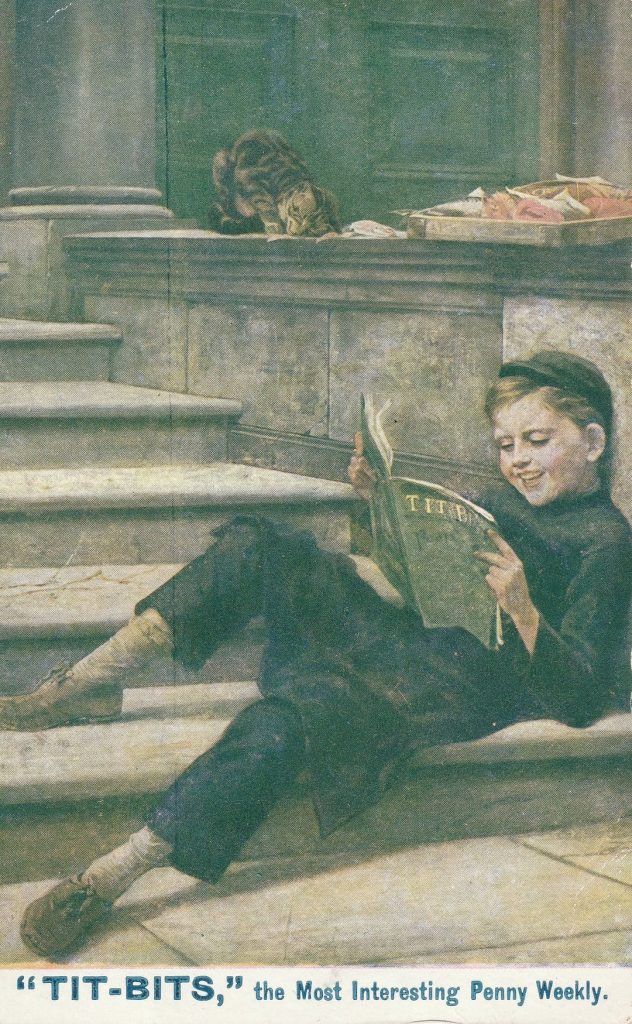Bob Teevan
A Cat and a Bit of History

This card was mailed on January 4, 1910 in Kentisbury, Barnstaple in North Devon, England, to Mrs. Bastin in the nearby village of Patchole.
The message is stuffy by some standards but reads: Mr. & Mrs. Simpson request the pleasure of yourself and family’s company on Thursday, January 13. Tea 5.30 sharp. Please let me know by Saturday, how many will come.
The message reads more like a summons than an invitation and it could be that either of the Simpsons instructed a domestic servant to issue the invitation on their behalf.
The postcard features a young boy relaxing on the steps of what may be a public building and reading a magazine. His clothes suggest he is working on the streets although his face is both fresh and remarkably clean. It may be he is in the employment of a fishmonger because it appears that a tray of fish awaits his attention on the wall behind him while he is reading Tit-Bits magazine. His enjoyment with what he is reading is there for all to see and the uncredited illustrator has suggested that the boy is so engrossed in the publication that a cat is now helping itself to the fish. There is no clue where the boy is having his relaxed read although the detail and quality of the image suggests a Dickensian era site in London.
The magazine being read is Tit-Bits that the title tells us is “The Most Interesting Penny Weekly.” There is no reference on the card as to a publisher but is in essence an advertisement for a publication which leads to the belief that it was published by the magazine itself.
Tit-Bits, which claimed to contain “tit bits from all the interesting books and newspapers of the world,” was a British weekly magazine founded by George Newnes in October 1881. Newnes was one of the early fathers of popular British journalism. From the outset, the magazine was a mass-circulation commercial publication on cheap newsprint which soon reached sales of between four- and six-hundred thousand. Like a mini-encyclopedia it presented a diverse range of information in an easy-to-read format, with the emphasis on human interest stories of great drama and high sensation. Pinups appeared on the magazine’s covers from 1939 and by 1955 circulation peaked at 1,150,000. Publication ceased in 1984 after a run of 103 years.
Those of a certain age will recall the magazine and will remember it was one passed around from friend-to-friend. This wasn’t a Readers Digest type publication and was more akin to a soft porn version of today’s gossip/celebrity publications. The quality of the material within may have changed considerably over the years but it is hard to imagine it having readers such as the Simpsons.
The word titbit, being used as a noun, is a small piece of gossip and it is easy to believe that the word was a consequence of the Tit-Bits publication and the type of stories it carried. But, it was no surprised to learn that the first use cited in the Oxford English Dictionary (OED) was in 1649, and is particularly British, and is in fact spelled differently: “A tyd bit, i.e., a speciall morsell reserved to eat at last.”
The first titbit (also British) appears in 1697 and the last, from T. A. Trollope, in 1887: “During the singing of the well-known tit-bits of any opera.” So, the word predates the publication by many years.
The card carries the line the Most Interesting Penny Weekly. I expected to find this line used regularly by the magazine over the years, but in fact, other than on the postcard, no other use of the phrase can be found. What I did find is that several publications, including, Northern Weekly Gazette, The Aberdeen Weekly Journal, and the Spare Moments publication used this phrase in advertising as early as 1890.
I had some fun trying to track down the sender and addressee of the card. Mrs. Bastin was Mrs. Eliza Bastin who in 1911 was the 57-year-old wife of John Bastin to whom she had been married for 33 years. John was a slightly younger 55 years of age and was a farmer who both lived at and worked the Patchole Farm. The couple had together produced five children. So, it was John and Eliza Bastin and their children who were invited to tea with Mr. and Mrs. Simpson.
It’s truly amazing what you can glean from the newspapers, and particularly when dealing with an unusual surname like Bastin and a village. I can see that Mrs. Bastin died on July 2, 1917.
As for Mr. and Mrs. Simpson, in the 1911 census, he was Octavius Nolan Simpson, 42, and she Emily Simpson, 33. They were married but without children. Mr. Simpson was of independent means while Mrs. Simpson was a head mistress at the Devon County Council. They lived at Sandpark Cottage, which today is a self-catering holiday home surrounded by gardens on the edge of Exmoor National Park. The house is ideal for family holidays and outdoors enthusiasts exploring this wonderful area of Devon.
And the cat? Well, he is just cute.
Such a wonderful vignette in one simple postcard. Sentimental, but absorbing.
“Tit-Bits” sounds like it filled the niche in Britain that such magazines as “True Story” did in the U.S.